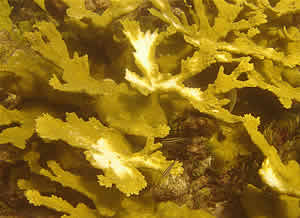
Elkhorn coral with bleaching, a condition that occurs with heat stress
One flash of hot summer weather may leave corals ailing for months, according to a new mathematical model based on Mote Marine Laboratory's studies of bacteria living on corals. The findings were recently reported in a study called "How Microbial Community Composition Regulates Coral Disease Development" published in the scientific journal Public Library of Science - Biology.
This model, developed through a collaboration between Mote and Cornell University, is the first to use math to describe how the protective bacteria on elkhorn corals suddenly gives way to disease-causing bacteria when corals are stressed. Elkhorn coral, (Acropora palmata), is listed as a threatened species under the Endangered Species Act.
Corals are constantly in contact with billions of microscopic life forms, including algae that live inside coral polyps and give corals color and energy. Other microorganisms â€" those that live in symbiosis with corals on their mucus-covered surfaces â€" are beneficial bacteria that produce protective antibiotics that keep corals healthy and harmful bacteria that lurk around, waiting to overrun stressed corals.
Mote scientist Dr. Kim Ritchie has studied the relationship between corals and their many microorganisms since the early 1990s and, more recently, in the Florida Keys National Marine Sanctuary â€" home to the world's third largest barrier reef.
In 2005, hot temperatures caused some Sanctuary corals to "bleach," or lose their helpful algae, and Mote research found that these corals subsequently lost beneficial bacteria and fell prey to harmful bacteria, especially species in the group Vibrio.
Now, in a new study led by Dr. Stephen P. Ellner of Cornell in collaboration with Ritchie, manager of Mote's Marine Microbiology Program, scientists have crafted a mathematical model describing how this bacterial takeover works.
If temperatures are mild enough, beneficial bacteria protect corals from the impacts of harmful bacteria by producing antibiotics that keep the "bad" bacteria in check. But when warming temperatures are added to the model's simulations, these bad bacteria gain a growth advantage, making it harder for the "good" bacteria to hold them back.
If waters get hot enough â€" even if it happens slowly â€" the model suggests that the good bacteria will be unable to pump out enough antibiotics, and the harmful bacteria will win.
"The really interesting thing is that even when corals go back to normal temperatures, there's a lag in the model where they don't regain their antibiotic activity," Ritchie said. "That's what we've been seeing in nature â€" our data from the Keys independently agrees with the model."
Following the 2005 coral bleaching event, Ritchie's team continued monitoring the Keys corals. Her results showed that more than six months after the warm spell, elkhorn corals still hadn't regained beneficial bacteria or the antibiotics they produce.
The model suggests that it may take cool winter temperatures to help good bacteria regain the upper hand. "I think the bottom line with this model is that corals don't recover as quickly as you think, even if they look healthy," Ritchie said. "The danger might not be over and resource managers need to be aware that corals may still be vulnerable."
In some cases, corals may be too damaged to wait for their defending bacteria to recover, and reefs can begin to die.
To understand what the future holds for coral reefs, Mote scientists plan to continue gathering data that can be used to refine this model and expand the real-world situations in which it can be applied.
"The great thing about having a mathematical model is that you can plug in parameters you think might be changing, like ocean acidification, and look at how this hypothetical change might affect corals," Ritchie said.
Scientists hope to better understand the nuts and bolts of how bad bacteria triumph in hot weather â€" does it become harder for good bacteria to make antibiotics in hot weather? Do harmful bacteria simply take the heat better? Does it allow them to move faster? And how do heat and bacterial invasion affect how the coral's immune system works?
Mote's data from sampling corals in the ocean will continue to help refine the model, bringing it closer to representing reality in corals' underwater world. This summer, Mote interns will continue efforts under Ritchie's guidance to study how changes in water temperature and acidity affect the growth rate of harmful and helpful bacteria on corals. Beck Frydenborg, a student at the University of Florida contributed data to the current paper as an intern participating in Mote's Research Experiences for Undergraduates (REU) Program funded by the National Science Foundation last summer.
Additional co-authors of this paper include Justin Mao-Jones and Laura E. Jones of Cornell University. The project was funded by the National Science Foundation and through a grant from Mote's Protect Our Reefs License Plate. Sales of the plate fund coral reef research, education and conservation. You can help protect corals by purchasing your plate today at: www.mote.org/4reef.
